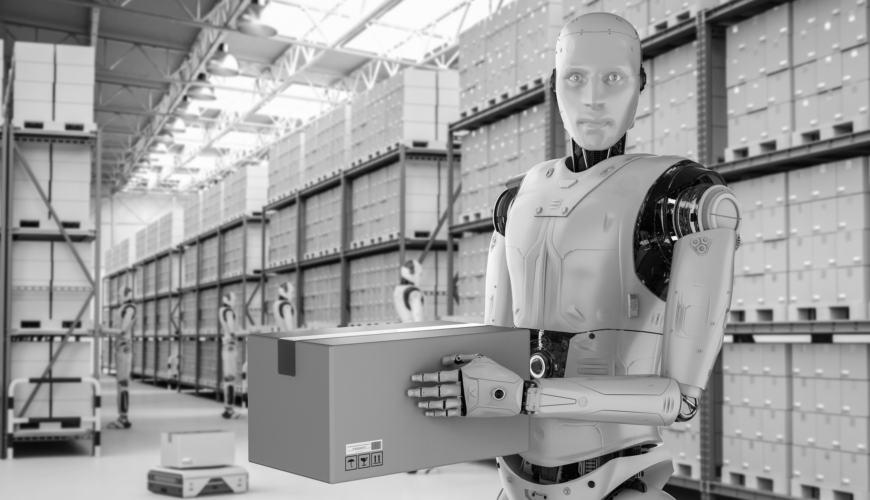Let’s explore the use of humanoid robots in various warehouse operations, predicting the areas where they will be deployed effectively and the timeline for their widespread adoption. The warehouse is the heart of supply chains, the linchpin that connects manufacturing to the customer. As e-commerce growth skyrockets and consumer expectations become more demanding in recent years, businesses have had to rethink their approach to logistics and fulfillment. One area showing tremendous promise in meeting these challenges is the integration of humanoid robots. These robots, which mimic human appearance and actions, offer significant advantages in dexterity, adaptability, and ease of integration into existing systems.
The Rise of Humanoid Robots in Warehouses: Why They’re the Next Frontier
Robots have long been used in warehouses, particularly in tasks that require repetitive, heavy lifting or high-precision handling, such as picking, packing, and sorting. However, most of these robots are specialized and stationary, designed for specific tasks like automated guided vehicles (AGVs), robotic arms, or conveyors. Humanoid robots, in contrast, are engineered to perform various functions that typically require human-level dexterity, mobility, and decision-making.
The appeal of humanoid robots lies in their versatility. Their form and function can replicate many human actions, such as bending, reaching, walking, and manipulating objects. This adaptability allows robots to take on more dynamic roles within the warehouse, from receiving and putaway to shipping and order fulfillment.
The Key Areas for Humanoid Robots in the Warehouse
The successful integration of humanoid robots into warehouse operations will likely be incremental, with early adoption starting in tasks that require flexibility, dexterity, and cognitive decision-making. Below are several key areas where humanoid robots are expected to make significant impacts.
Receiving and Unloading
In the receiving and unloading stage, warehouse workers typically unload shipments from trucks and transport items to designated storage areas. This process involves various tasks, from opening boxes to organizing products on pallets or shelving units. Humanoid robots, equipped with advanced sensors, cameras, and AI, could take over these tasks, drastically reducing human labor and improving efficiency.
Humanoid robots can identify items through computer vision and autonomously unload pallets and boxes from trucks. Their dexterous hands and precise motor functions could allow them to unpack boxes, scan items, and sort them based on size, shape, or destination. Unlike traditional robotic systems, humanoid robots can handle various packages and products, including irregularly shaped or fragile goods, making them highly adaptable to fluctuating demands.
The timeline for deploying humanoid robots in receiving will likely begin in the next 5–7 years as the technology for handling diverse product types and environments matures. AI systems would need to become increasingly adept at identifying and sorting items across different categories, which may require a combination of machine learning and sensory technologies.
Putaway
Once goods are received, they must be stored in the most efficient and accessible locations within the warehouse. This process, known as putaway, often involves tasks like moving items from the receiving area to shelving, bins, or pallet racking systems.
Humanoid robots could improve the putaway process by efficiently navigating the warehouse to store goods in optimal locations without extensive human oversight. Their ability to walk, climb, and bend allows them to reach storage locations that may be difficult for traditional robotic arms or AGVs to access. Equipped with advanced AI, humanoid robots can also learn and adapt to changing layouts, optimizing storage based on shifting product demand and inventory levels.
Deployment of humanoid robots in putaway could start within the next 3–5 years. However, their widespread adoption will depend on overcoming challenges like precise navigation, real-time inventory updates, and the integration of humanoid robots with automated storage systems.
Picking
Picking, the process of retrieving specific items from shelves or storage locations to fulfill customer orders, is one of the most labor-intensive and error-prone tasks in the warehouse. It requires the robot to navigate aisles, identify products, and handle a wide variety of items, including fragile or irregularly shaped goods.
Humanoid robots are well-suited for picking tasks because of their flexibility and dexterity. Unlike traditional robotic arms, which are typically confined to a fixed location or need to be specialized for a single product type, humanoid robots can move freely through the warehouse, interact with a variety of shelving types, and adjust their posture to pick products from a wide range of heights and depths.
Equipped with advanced computer vision, machine learning, and real-time navigation, humanoid robots can quickly identify products, assess their condition, and choose the best handling method. Their agility makes them highly effective in environments where goods are stored in various configurations, and their ability to adapt to new types of products and packaging could significantly improve picking efficiency and accuracy.
Realistically, humanoid robots will begin taking over simple picking tasks in the next 4–6 years. These robots may first be deployed in specialized areas such as small item picking or in environments where human workers are needed to manage diverse or fragile products. As AI and machine learning capabilities evolve, widespread use across all picking scenarios could occur by the early 2030s.
Packing
Packing is another area where humanoid robots will likely play a critical role. This task involves organizing items into boxes, ensuring they are packed efficiently, and preparing them for shipment. It requires a combination of dexterity, spatial awareness, and decision-making, all skills that humanoid robots are well-suited to handle.
In the packing process, humanoid robots could be programmed to identify the optimal way to arrange items in a box, ensuring that products are packed securely without wasted space. Their advanced hands and fingers, combined with machine learning algorithms, will allow them to handle fragile products with care, avoid breakage, and pack items in ways that minimize damage during transit.
Humanoid robots will also be able to interact with various packaging materials, such as boxes, bubble wrap, and tape, and adjust their actions based on the type of products being packed. For example, a humanoid robot could be programmed to switch between packing small, lightweight items or large, bulky goods.
Given the complexity of the packing process, humanoid robots may begin to be deployed for packing tasks in the next 5–7 years. While many packing functions can be automated with specialized robots today, humanoid robots will bring greater flexibility and adaptability, enabling them to handle a broader range of product types and packaging configurations.
Manifesting and Labeling
Manifesting and labeling involve generating shipping documentation and affixing labels to packages, a critical step in ensuring accurate delivery. While many warehouses use automated labeling systems today, humanoid robots could take this process a step further by adding flexibility and reducing the need for human intervention.
Humanoid robots could be tasked with scanning items, generating shipping labels, and affixing those labels to boxes. Equipped with advanced AI and image recognition, these robots could also ensure that the correct labels are applied to each package, reducing errors and improving traceability. Additionally, humanoid robots could automate the preparation of manifests and other shipping documentation, streamlining the shipping process.
Given the routine nature of this task, humanoid robots may be deployed in the manifesting and labeling stages within the next 3–5 years. Their deployment would likely start with smaller warehouses and expand as the robots become more reliable and cost-effective.
Shipping and Loading
The shipping stage in a warehouse involves organizing packages for transport and ensuring that they are loaded onto trucks in the correct order for delivery. Humanoid robots could improve this process by automating goods loading into transport vehicles.
Humanoid robots would be capable of moving packages, stacking them in trucks, and even optimizing the order of items to ensure efficient transport. Their ability to navigate spaces with varying dimensions and use their hands to manipulate items gives them a distinct advantage over other robotic systems, such as AGVs, which can struggle with irregularly shaped loads or complex layouts.
In the shipping and loading area, humanoid robots could begin deployment in the next 5–7 years, particularly in warehouses with flexible layouts or a diverse range of shipped items. Over time, as robots become better at coordinating with other warehouse systems, their role in this area could grow.
Maintenance and Inventory Management
Beyond the direct fulfillment process, humanoid robots could also assist in maintaining warehouse operations. Their ability to move freely through the warehouse and interact with various systems could make them ideal for conducting routine maintenance checks, monitoring equipment health, and even performing minor repairs.
Additionally, humanoid robots could be used for inventory management tasks. Equipped with RFID readers, barcode scanners, and sophisticated tracking software, these robots could autonomously roam the warehouse, scan products, and update inventory records in real time. This would significantly reduce the need for manual stocktaking and improve inventory accuracy, which is crucial for optimizing stock levels and reducing supply chain disruptions.
Adopting humanoid robots for maintenance and inventory management could begin within 3–5 years, as these tasks are highly repetitive and could benefit from automation. As technology advances, humanoid robots will likely take on more complex maintenance and management tasks, eventually becoming integral to warehouse operations.
Challenges to Overcome Before Full Deployment
While the potential benefits of humanoid robots in warehouses are clear, several challenges must be addressed before widespread adoption can occur. These include:
- Cost and ROI: Humanoid robots are still relatively expensive to develop and deploy compared to traditional automation solutions. Companies must justify investment by demonstrating clear improvements in efficiency, cost savings, and ROI.
- Technology Maturity: Advanced AI, machine learning, and robotics technology must evolve further to ensure that humanoid robots can perform various warehouse tasks autonomously, efficiently, and safely.
- Integration with Existing Systems: Humanoid robots must be integrated into warehouse management systems (WMS), automated storage solutions, and other digital infrastructure. This requires significant investments in both hardware and software to ensure seamless coordination across the warehouse.
- Safety and Human-Robot Collaboration: Humanoid robots will work alongside human workers, ensuring their safe operation is critical. This involves developing sophisticated safety protocols and ensuring that robots can collaborate with humans without introducing risks to workers’ safety.
- Workforce Reskilling: As robots take over more tasks, human workers must be retrained for higher-level roles, such as supervising robots, maintaining automation systems, or managing complex logistics processes.
A Decade of Transformation
Humanoid robots are poised to revolutionize warehouse operations over the next decade. While early deployments will likely focus on specific tasks such as packing, labeling, and shipping, their versatility and adaptability will eventually make them key players in warehouse management, from receiving and putaway to picking and inventory management.
The widespread adoption of humanoid robots in warehouses will depend on advances in AI, robotics, and automation, as well as overcoming cost and integration challenges. However, the potential benefits—improved efficiency, reduced labor costs, enhanced accuracy, and increased flexibility—make humanoid robots an exciting prospect for the future of logistics.
In the next 5 to 10 years, humanoid robots will become increasingly common in warehouses worldwide, reshaping the logistics landscape and setting the stage for the next generation of supply chain automation.


